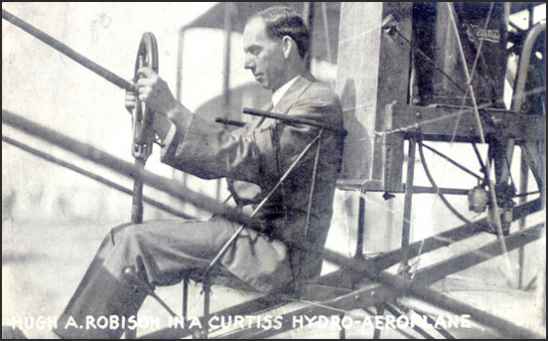
1881-1963 AKA Hugh Robison |
 |
Collection of Jean-Pierre Lauwers, 12-15-04 |
Via email from Jean-Pierre Lauwers, 12-18-04 He may have been the first to make an air-sea rescue when he saved a crashed pilot by making a landing on Lake Michigan in August, 1911 ? |
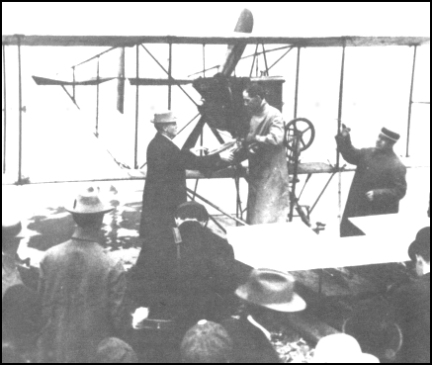 |
| Missouri Historical Society |
|
Hugh Robinson ascended from the Mississippi River in this Curtiss seaplane on October 8, 1911. Here he accepts a sack
of mail, which he flew to the east side, then back to Missouri again. This was the first seaplane flight in St. Louis. The History of Aviation in St. Louis by James J. Horgan The Patrice Press |
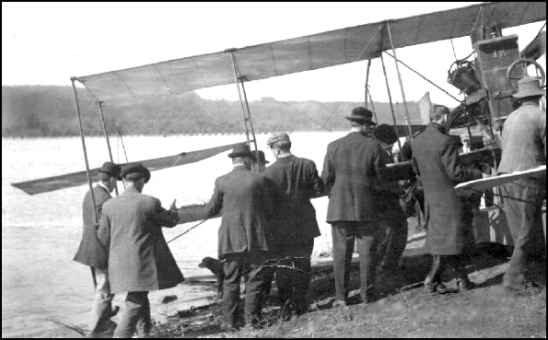 |
Photo & Text Courtesy of Roy Nagl, 9-14-05 |
|
A number of local inventors also expressed their intentions of exhibiting machines during Centennial Week. Frederick Barolom, the son of the president of the National Bank of Commerce, built an airplane at his home and planned to fly it during the celebration if he could find a suitable engine. It was a monoplane 7 feet long and 26 feet in span, with a single propeller. Hugh A. Robinson, a member of the Aero Club, perfected his third airplane at the shops of the Dorris Automobile Company, where he was employed. Patterned after the Hugh Latham monoplane, it was 34 feet long and had a wing area of 240 square feet. The machine weighed 600 poounds and, propelled by a 25-horsepower motor, it ws expected to attain a speed of forty miles per hour. On October 4, St. Louis' Hugh Robinson brought his airplane to Forest Park for trials, but it did not have sufficient power to rise from the ground. On October 7, Hugh was on the Forest Park field, but by the time he was ready, it was too dark to fly. |
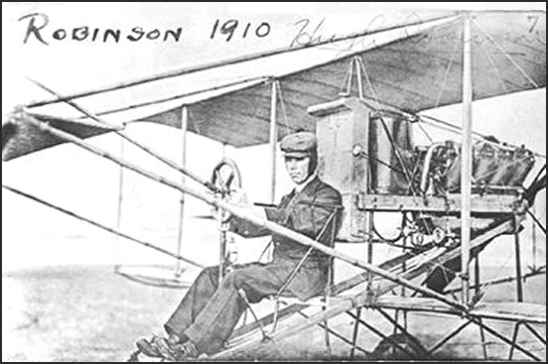 |
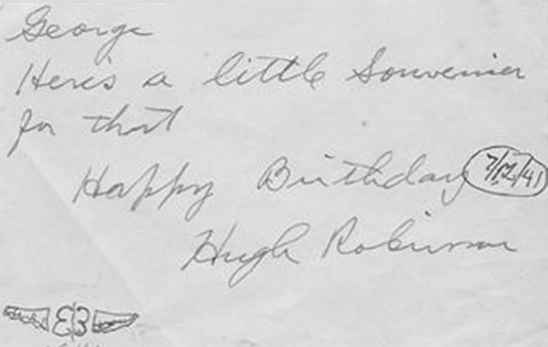 |
|
Collection of Robert Arnold, George's son, 8-10-04 |
|
At the Washington Park field an aviation meet for novices was conducted by the Aero Club in July 1910. The tournament was deemed a success, although it saw "no real flying." It did, however, stimulate the building of aircraft by many residents of the city. Hugh A. Robinson and Frederick Van Baralom perfected the monoplanes that they had attempted to demonstrate during Centennial Week in 1909 |
|
CHIRP, SATURDAY, AUGUST 17, 1935, DETROIT MICHIGAN If I am not mistaken, that is the exact date when Glenn Curtiss and I were flying at this meet and Beachey popped in on us and wanted to become an aviator. So Curtiss told me to take him out over the back stretch and let him take a hop. This was the last hop that pusher ever made for he piled it up and it was a complete washout. Fortunately Beachey crawled out unhurt. Curtiss said he had no more planes to wreck just then and Beachey disappeared. It was some time later that I heard he had learned to fly. In fact, as I remember, when Ely had the contract to fly from Key West to Havana, Curtiss discovered that the contract called for two aviators. Whether or not the second aviator could fly did not matter, so Curtiss laughingly decided to send Beachey. Accordingly, Beachey went to Key West with Ely in one of the old machines. But from information I gathered later, he piled up the old machine at Key West and it was not until some time later that he actually began flying. |
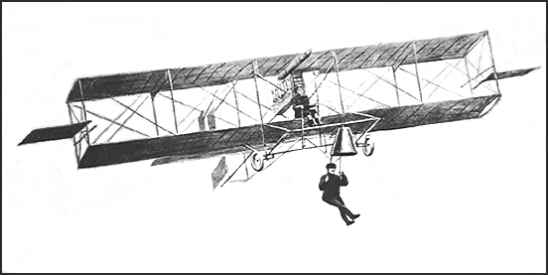 |
|
St. Louis Mo, January 12th 1911. Benoist Airplane built by Hugh Robinson and Tom Benoist; Roberts Two Cycle Marine Engine. Jump made by Capt John Berry; Start from Kinloch Field and landed on parade ground of Jefferson Barracks, St. Louis Parachute and apparatus designed and built by Hugh Robinson Collection of Robert Arnold, 8-10-04 |
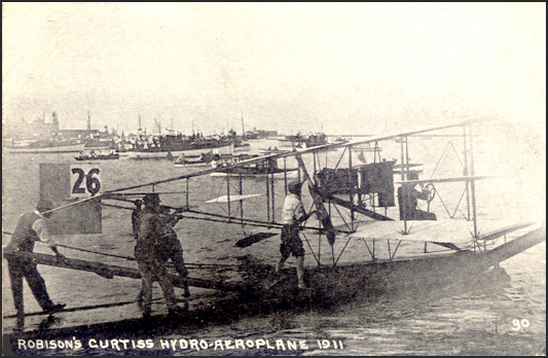 |
|
Collection of Jean-Pierre Lauwers, 12-15-04 |
|
Daily Journal and Tribune, Knoxville, Tennessee: September 18, 1911, Transcribed by Bob Davis - 11-16-03 His trip down the river will be in easy stages. The start is timed for the opening of the deep waterways convention in Chicago. Every effort will be made to call attention to length and the possibilities of the Mississippi river and the importance of cities located on it. Robinson was selected from over forty applicants...." Bob Davis |
 |
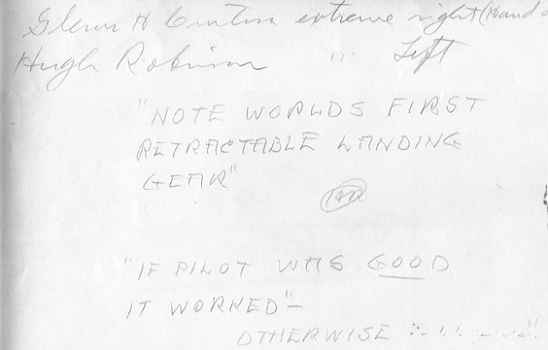 |
|
On October 21, the Aereo Club received word that Hugh Robinson had abandoned the Minneapolis-New Orleans flight which he had begun on October 17 (four days late). He needed $20,000 for expenses, and the towns along the river had raised a sufficient fund for him. They began to withdraw their commitments, however, when the aviator refused to give definite dates for his arrival, since his movements depended on wind and weather conditions. When Robinson reached Rock Island, Illinois, 371 miles from his starting point, he sent a telegram in desperation to Albert Bond Lambert, demanding that the Aero Club of St. Louis, his home organization, increase its $500 subscription. The Aero Club president responded: Your telegram demanding $2,000 and threat to end flight at Rock Island received. As the sum we have raised for you does not amount to $2,000 we withdraw any and all guarantees we had for you to arrive here on your way to New Orleans The St. Louis aviator carried out his threat and ended his flight at Rock Island. The venture cost the Curtiss Exhibition Company an estimated $5,000 The History of Aviation in St. Louis by James J. Horgan The Patrice Press |
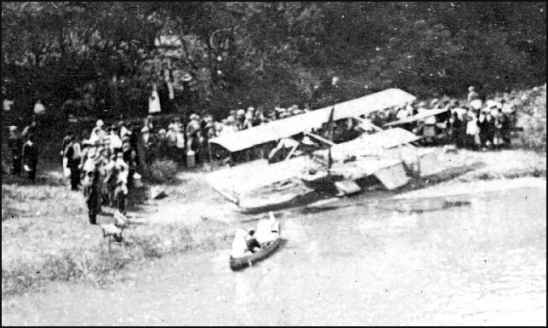 |
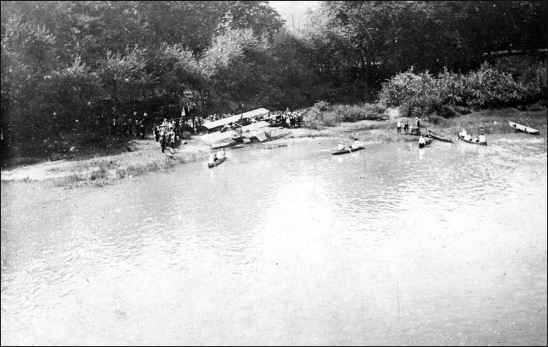 |
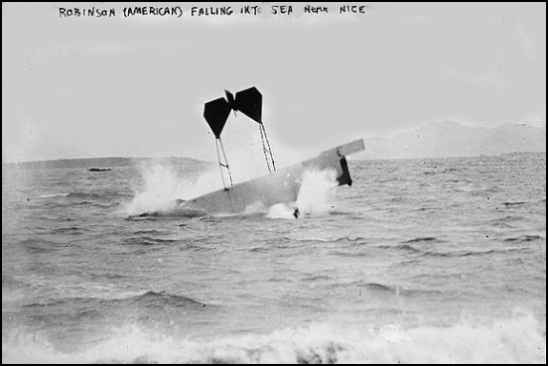 |
Photo shows airplane of pilot and daredevil Hugh Armstrong Robinson making a crash landing on water near Nice, France, 1912. (Source: Flickr Commons project, 2009 and Metropolitan magazine, July 1912) Library of Congress Collection, |
|
|
|
|
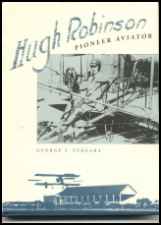 |
HUGH ROBINSON Pioneer Aviator George L. Vergara Product Details Cloth: 136 pages; 6x9 inches Publisher: University Press of Florida, 1995 List Price: $29.95 Used & new: from $2.47 ISBN: 0-8130-1361-5 |
|
Description: "Hugh Robinson (1881-1963) was a daredevil, a compulsive inventor, an important figure in the early hstory of American aeronautics, and one tough customer. He survived test flights, fifteen serious crashes, the "Circle of Death" circus act (his own invention), and spectacularly dangerous international air shows. Based on the Robinson family's trove of early aviation memorabilia and 82 rare photographs, this biography dscribes his passage from childhood--when he attempted to fly his homemade bicycle off a 100-foot-high-hill- to his final years as a consulting enginer for National Scientific Laboratories in Washington, D.C......." |
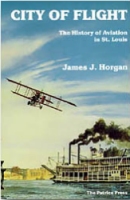 |
CITY OF FLIGHT: The History of Aviation in St. Louis James J. Horgan Product Details Cloth: 500 pages; 6 1/2 x 9 inches Publisher: Patrice Press, 1984 Used: $17.95 ISBN: 0-935284-35-4 |
|
Description: "From time to time, in the body of scholarly writing, there emerges a work of commanding importance. Somtimes this paper will do more than satisfy a committee; sometimes it will go beyond a noble contribution to the sum of our knowledge and will also entertain the reader. Occasionally it will be couched in plain, easy-to-understand journalism, designed to captivate a person with a sense of being there. City of Flight is all of this. James J. Horgan transports his reader into history; into the basket of the Atlantic, as the 19th century balloon crashes into the timber of upstate New York, a thousand miles after its takeoff from St. Louis. Into the Red Devil, as Thomas Scott Baldwin flies his flimsy biplane between the Mississippi River and the arches of Eads Bridge. Onto the struts of the Sky Cycle, as a 15-year-old boy pedals his little gas-filled dirigible over Forest Park. Onto Art Hill, to cheer the flyover of America's newest hero, Charlese A. Lindgergh, in his Spirit of St. Louis, in salute to the city which made it all possible. This is an epic set in the very cradle of aviation history - the City of St. Louis - now, as it was in the beginning, the City of Flight." |
|
From The Early Birds of Aviation Roster, 1996 |


|